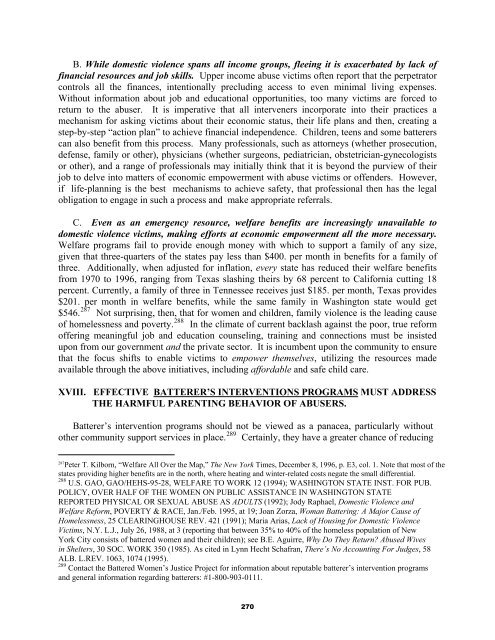A Judge’s Guide
A Judge’s Guide
A Judge’s Guide
Create successful ePaper yourself
Turn your PDF publications into a flip-book with our unique Google optimized e-Paper software.
B. While domestic violence spans all income groups, fleeing it is exacerbated by lack of<br />
financial resources and job skills. Upper income abuse victims often report that the perpetrator<br />
controls all the finances, intentionally precluding access to even minimal living expenses.<br />
Without information about job and educational opportunities, too many victims are forced to<br />
return to the abuser. It is imperative that all interveners incorporate into their practices a<br />
mechanism for asking victims about their economic status, their life plans and then, creating a<br />
step-by-step “action plan” to achieve financial independence. Children, teens and some batterers<br />
can also benefit from this process. Many professionals, such as attorneys (whether prosecution,<br />
defense, family or other), physicians (whether surgeons, pediatrician, obstetrician-gynecologists<br />
or other), and a range of professionals may initially think that it is beyond the purview of their<br />
job to delve into matters of economic empowerment with abuse victims or offenders. However,<br />
if life-planning is the best mechanisms to achieve safety, that professional then has the legal<br />
obligation to engage in such a process and make appropriate referrals.<br />
C. Even as an emergency resource, welfare benefits are increasingly unavailable to<br />
domestic violence victims, making efforts at economic empowerment all the more necessary.<br />
Welfare programs fail to provide enough money with which to support a family of any size,<br />
given that three-quarters of the states pay less than $400. per month in benefits for a family of<br />
three. Additionally, when adjusted for inflation, every state has reduced their welfare benefits<br />
from 1970 to 1996, ranging from Texas slashing theirs by 68 percent to California cutting 18<br />
percent. Currently, a family of three in Tennessee receives just $185. per month, Texas provides<br />
$201. per month in welfare benefits, while the same family in Washington state would get<br />
$546. 287 Not surprising, then, that for women and children, family violence is the leading cause<br />
of homelessness and poverty. 288 In the climate of current backlash against the poor, true reform<br />
offering meaningful job and education counseling, training and connections must be insisted<br />
upon from our government and the private sector. It is incumbent upon the community to ensure<br />
that the focus shifts to enable victims to empower themselves, utilizing the resources made<br />
available through the above initiatives, including affordable and safe child care.<br />
XVIII. EFFECTIVE BATTERER’S INTERVENTIONS PROGRAMS MUST ADDRESS<br />
THE HARMFUL PARENTING BEHAVIOR OF ABUSERS.<br />
Batterer’s intervention programs should not be viewed as a panacea, particularly without<br />
other community support services in place. 289 Certainly, they have a greater chance of reducing<br />
287 Peter T. Kilborn, “Welfare All Over the Map,” The New York Times, December 8, 1996, p. E3, col. 1. Note that most of the<br />
states providing higher benefits are in the north, where heating and winter-related costs negate the small differential.<br />
288 U.S. GAO, GAO/HEHS-95-28, WELFARE TO WORK 12 (1994); WASHINGTON STATE INST. FOR PUB.<br />
POLICY, OVER HALF OF THE WOMEN ON PUBLIC ASSISTANCE IN WASHINGTON STATE<br />
REPORTED PHYSICAL OR SEXUAL ABUSE AS ADULTS (1992); Jody Raphael, Domestic Violence and<br />
Welfare Reform, POVERTY & RACE, Jan./Feb. 1995, at 19; Joan Zorza, Woman Battering: A Major Cause of<br />
Homelessness, 25 CLEARINGHOUSE REV. 421 (1991); Maria Arias, Lack of Housing for Domestic Violence<br />
Victims, N.Y. L.J., July 26, 1988, at 3 (reporting that between 35% to 40% of the homeless population of New<br />
York City consists of battered women and their children); see B.E. Aguirre, Why Do They Return? Abused Wives<br />
in Shelters, 30 SOC. WORK 350 (1985). As cited in Lynn Hecht Schafran, There’s No Accounting For Judges, 58<br />
ALB. L.REV. 1063, 1074 (1995).<br />
289 Contact the Battered Women’s Justice Project for information about reputable batterer’s intervention programs<br />
and general information regarding batterers: #1-800-903-0111.<br />
270


